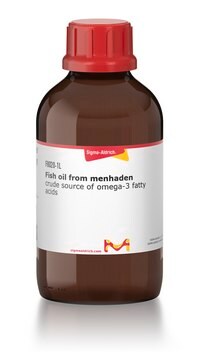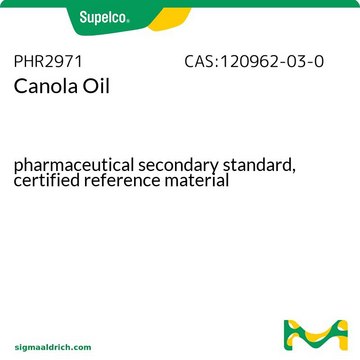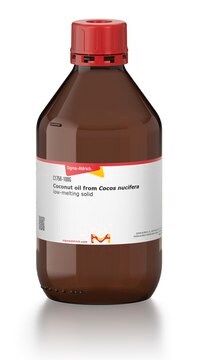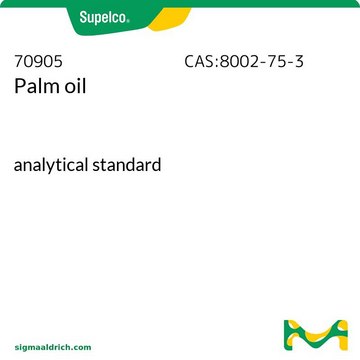Empfohlene Produkte
Form
liquid
Qualitätsniveau
Verunreinigungen
~0.5% free fatty acids
Funktionelle Gruppe
oleic acid
Lipid-Typ
oils
Versandbedingung
ambient
Lagertemp.
2-8°C
Suchen Sie nach ähnlichen Produkten? Aufrufen Leitfaden zum Produktvergleich
Verwandte Kategorien
Biochem./physiol. Wirkung
Lard oil may be used to test the properties of antioxidants such as flavonoids and as a producer of mutagens and oxidants in oil smoke.
Lagerklassenschlüssel
10 - Combustible liquids
WGK
awg
Flammpunkt (°F)
Not applicable
Flammpunkt (°C)
Not applicable
Persönliche Schutzausrüstung
Eyeshields, Gloves, multi-purpose combination respirator cartridge (US)
Hier finden Sie alle aktuellen Versionen:
Besitzen Sie dieses Produkt bereits?
In der Dokumentenbibliothek finden Sie die Dokumentation zu den Produkten, die Sie kürzlich erworben haben.
T A Chiang et al.
Food and chemical toxicology : an international journal published for the British Industrial Biological Research Association, 37(2-3), 125-134 (1999-05-05)
According to toxicological studies, there are several unidentified mutagens derived from cooking oil fumes appearing in kitchens of Chinese homes where women daily prepare food. Data are limited to an analysis of aromatic amines from cooking oil fumes, which are
P F Wu et al.
Mutation research, 403(1-2), 29-34 (1998-09-03)
According to earlier studies, fumes from cooking oils were found to be mutagenic and several polycyclic aromatic hydrocarbons (PAHs), (benzo(a)pyrene (B(a)P), benz(a)antracene (B(a)A), and dibenz(a,h)anthracene (DB(ah)A)) were identified. Fume samples from three different commercial cooking oils frequently used in Taiwan
Li Ping-Chia et al.
Journal of biomedical science, 16, 58-58 (2009-07-07)
Airborne particulate matter, from cooking oil, smoking, engine exhaust and other sources, is associated with the development of atherosclerosis and myocardial infarction. In order to explore the cellular and molecular events following exposure of rats to lard oil smoke, we
Unser Team von Wissenschaftlern verfügt über Erfahrung in allen Forschungsbereichen einschließlich Life Science, Materialwissenschaften, chemischer Synthese, Chromatographie, Analytik und vielen mehr..
Setzen Sie sich mit dem technischen Dienst in Verbindung.








